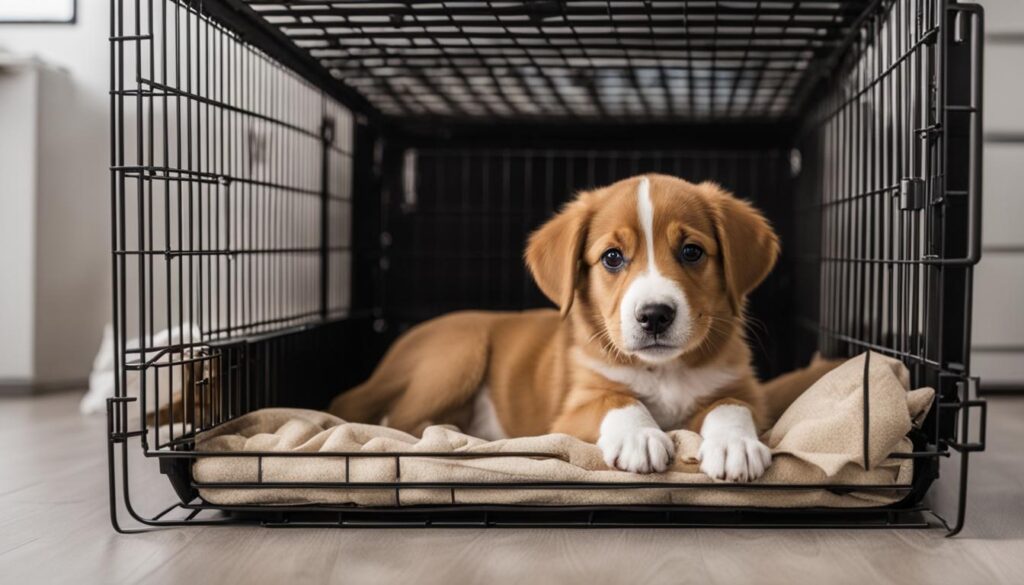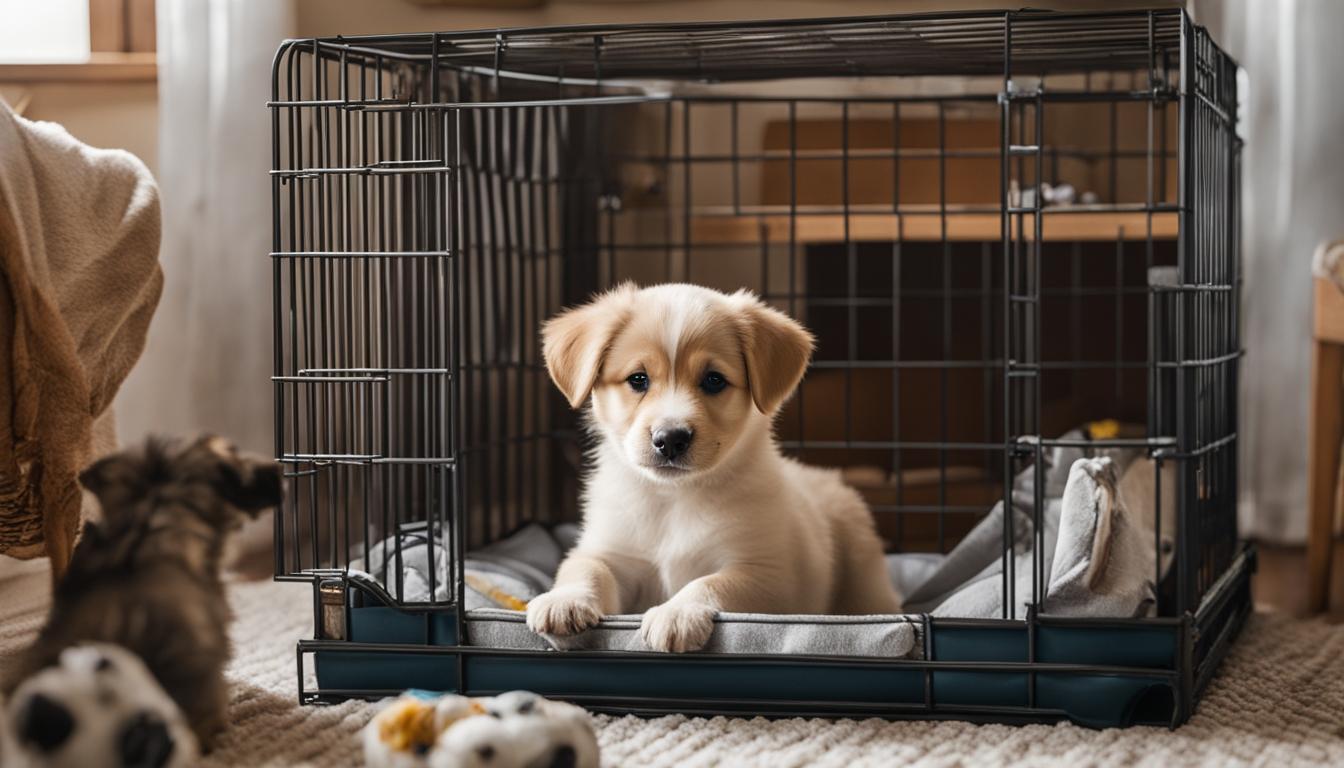Are you wondering why crate train a puppy? Crate training is highly recommended by veterinarians, trainers, and breeders for dogs of all ages. It offers numerous benefits that promote the well-being and safety of your furry friend.
Crates provide a sense of security for dogs, giving them a safe haven to retreat to when they need a break or feel anxious. They also offer peace of mind for owners, ensuring that their dogs are safe during emergencies or when left alone.
Crate training is especially beneficial during the housebreaking phase for puppies. It helps them learn bladder and bowel control, preventing accidents in the house and teaching them to hold their needs until taken outside. Crates also play a crucial role in providing a secure space for senior dogs, allowing them to rest and relax comfortably.
In addition to housebreaking and providing a safe haven, crate training assists dogs in adapting to new situations, reducing stress during travel, and aiding in behavioral development. It also facilitates the successful introduction of changes in the household, such as the arrival of a new baby or having guests over.
By crate training your puppy or dog, you are laying the foundation for a well-behaved and disciplined pet that feels safe and secure in various situations.
Key Takeaways:
- Crate training provides a sense of security for dogs.
- It aids in housebreaking puppies and helps prevent accidents in the house.
- Crates offer a safe space for senior dogs to rest and relax.
- They assist dogs in adapting to new situations and reducing stress during travel.
- Crate training facilitates behavioral development and successful introduction of changes in the household.
Encouraged by Breeders and Vets
When it comes to crate training your dog, you can trust the advice of experienced professionals. Veterinarians, trainers, and breeders all recommend crate training from a young age for a variety of reasons. One of the primary benefits of crate training is its effectiveness in housebreaking puppies. Dogs naturally do not want to soil their sleeping space, so using a crate helps them learn to hold their bladder and bowel movements, preventing accidents inside the house.
In addition to housebreaking, crate training also provides several other advantages. It allows for quick and safe evacuation during emergencies, reducing the risk of dogs getting lost or injured. This is especially important for pet owners who live in areas prone to natural disasters. Furthermore, crates enable dogs to stay with their owners in shelters during emergencies, providing them with a familiar and secure environment.
Crate training is not just for emergencies; it is beneficial for dogs in everyday life as well. Crates serve as a safe haven where dogs can retreat and feel secure when they need a break or are feeling anxious. They also make it easier to introduce dogs to new situations or changes in the household, such as the arrival of a new baby or having guests over. Additionally, crates are essential for safe transportation of dogs during travel, ensuring their comfort and security.
In conclusion, the recommendation of breeders and vets to crate train your dog is rooted in the numerous benefits it offers. From housebreaking puppies to providing a safe space for dogs in emergencies and everyday life, crate training promotes security, discipline, and overall well-being for our furry friends.
Crate Training for Everyday Life
Crate training is not only useful during emergencies but also in everyday life. Crates provide dogs with a safe space to retreat to when they need a break or feel anxious. They help dogs self-soothe and cope with stressful situations such as fireworks or thunderstorms. Crates also aid in the successful introduction of new situations or changes in the household, such as the arrival of a new baby or having guests over. Additionally, crates make it easier to transport dogs safely in cars or planes during travel.
Having a crate for your dog in your everyday life can bring numerous advantages. It creates a designated space for your dog where they can relax and feel secure, which can be especially beneficial in busy and sometimes overwhelming households. Whether it’s loud noises, new people, or changes in the environment, dogs can find comfort and solace in their crates. It becomes their own personal den, a place where they can feel protected.
“Crates can be a game-changer when it comes to managing stress and anxiety in dogs,” says Dr. Samantha Collins, a renowned veterinarian. “Having a safe space for them to retreat to can significantly reduce their stress levels and promote their overall well-being.”
Another practical aspect of crate training for everyday life is its convenience during transportation. Whether you’re going on a road trip or taking your dog on a plane, having a crate ensures their safety and comfort throughout the journey. It prevents them from moving around and getting injured, and it also helps them feel secure in unfamiliar environments.
With these advantages, crate training becomes an essential part of a dog’s everyday life, providing them with a sense of security, helping them cope with stress, and facilitating safe and comfortable travel.
| Benefits of Crate Training for Everyday Life: |
|---|
| Provides a safe space for dogs to retreat to in stressful situations |
| Aids in the successful introduction of new situations or changes in the household |
| Makes transportation safer and more comfortable for dogs |
Benefits for Puppies
Crate training is particularly beneficial for puppies as it provides them with a safe and confined space to rest and learn bladder and bowel control. By using a crate, you can effectively housebreak your puppy by teaching them to hold their bladder and bowel movements. This helps prevent accidents in the house and promotes good hygiene habits.
Additionally, crates prevent destructive behaviors that puppies often exhibit when left unsupervised. Puppies have a natural tendency to chew on furniture, shoes, and other household items. However, when properly crate trained, they are confined to a safe space and less likely to engage in destructive behavior.
Crate training at an early age also helps puppies become familiar with being confined, which can be beneficial in various situations. For example, when visiting the veterinarian or traveling, puppies who are crate trained are more comfortable and feel secure. It also helps prevent stress and anxiety later on as the puppy grows into an adult dog.

| Benefits | Description |
|---|---|
| Housebreaking | Crate training teaches puppies to hold their bladder and bowel movements, preventing accidents in the house. |
| Prevents Destructive Behavior | Puppies are less likely to engage in destructive behaviors when confined to a crate. |
| Comfort and Security | Puppies feel safe and secure in their crate, reducing stress and anxiety. |
| Easy Vet Visits and Travel | Crate trained puppies are more comfortable during visits to the veterinarian or when traveling. |
Overall, crate training is a valuable tool for puppy owners. It not only aids in housebreaking and preventing destructive behavior but also provides a secure and comfortable space for puppies to rest and adapt to new situations. By crate training your puppy, you are setting them up for a lifetime of good behavior and discipline.
Benefits for Senior Dogs
Crate training is not limited to puppies; it is also beneficial for senior dogs. Crates provide a comfortable and restful place for senior dogs to relax and take frequent naps. They prevent nighttime wandering and make it easier to transport senior dogs to vet appointments. Crates also offer a safe haven for older dogs, especially when surrounded by rambunctious children or other dogs. Crate training helps senior dogs deal with health issues and provides them with a sense of security.
Senior dogs often have specific needs, and crate training can cater to those needs effectively. The use of a crate allows senior dogs to have a designated space where they can rest and recharge without any disturbances. This is especially important as older dogs may have reduced mobility or joint issues that require them to take frequent breaks.
In addition to providing a peaceful resting area, crates also aid in transporting senior dogs. Whether it’s a routine visit to the vet or a family outing, having a crate-trained senior dog makes the entire process safer and less stressful for everyone involved. The crate serves as a secure and familiar space, offering reassurance and minimizing anxiety during travel.
| Benefits of Crate Training for Senior Dogs |
|---|
| Provides a comfortable resting place |
| Prevents nighttime wandering |
| Facilitates transportation to vet appointments |
| Offers a safe retreat from rambunctious activity |
| Aids in managing health issues |
Crate training for senior dogs is a valuable tool that enhances their overall well-being and quality of life. It allows them to have a dedicated space where they can find solace, rest, and feel secure. The benefits of crate training extend beyond the immediate convenience, providing senior dogs with a safe haven that promotes their physical and emotional health.
Benefits for Rescued Dogs
Rescued dogs often come from challenging backgrounds and may have experienced trauma or abuse. Crate training can be a valuable tool in helping these dogs adjust to their new environment and feel safe and secure. By providing a designated space that is solely theirs, a crate gives rescued dogs a sense of ownership and control.
One of the significant advantages of crate training for rescued dogs is that it can help reduce behavior issues commonly seen in these dogs. Barking, destructive behavior, and separation anxiety are just a few examples of behavioral challenges that can be addressed through crate training. The crate acts as a sanctuary where they can feel comfortable and relax, alleviating their anxiety and stress levels.
“The crate provides a safe space for rescued dogs, helping them overcome their past traumas and build confidence.”
Crate training also facilitates the crucial process of housebreaking in rescued dogs. It teaches them bladder and bowel control and establishes a routine, making it easier for them to adapt to their new home. Additionally, crate training can aid in the successful integration of rescued dogs into a household by providing them with a safe space where they can retreat and adjust at their own pace.
Table: Crate Training Benefits for Rescued Dogs
| Benefits | Description |
|---|---|
| Security and Comfort | The crate provides a safe and secure space where rescued dogs can feel protected and at ease. |
| Behavioral Improvement | Crate training helps reduce common behavior issues in rescued dogs, such as barking, destructive behavior, and separation anxiety. |
| Housebreaking | The crate facilitates the housebreaking process in rescued dogs, teaching them bladder and bowel control. |
| Adjustment and Integration | Crate training assists in the successful integration of rescued dogs into a household, allowing them to adjust at their own pace. |

Benefits for Hunting Dogs
When it comes to crate training, hunting dogs can reap numerous benefits. Whether you have a seasoned hunting companion or are training a young gun dog, crates play a crucial role in their comfort and safety. By utilizing crate training techniques, you can ensure that your hunting dog stays clean, contained, and disciplined.
Hunting dogs often encounter muddy fields, dense vegetation, and water bodies during hunts. With regular crate training, you can keep your dog comfortable and prevent them from tracking dirt and debris into your vehicle or home. The crate serves as a designated space for your hunting dog to rest and recover, promoting their well-being and energy levels throughout the hunting season.
Additionally, crates are essential during transportation to and from hunting locations. They provide a secure and controlled environment for your hunting dog, ensuring a smooth journey. Whether you’re traveling by car or plane, crates help to minimize stress and keep your dog safe during transit.
| Benefits of Crate Training for Hunting Dogs | Details |
|---|---|
| Comfort and Rest | Crates provide a comfortable space for hunting dogs to rest and recharge during breaks in the field. |
| Containment and Cleanliness | Crate training keeps hunting dogs contained, preventing them from tracking dirt and mud into your vehicle or home. |
| Safe Transportation | Crates ensure the safety of hunting dogs during travel, whether by car or plane. |
| Discipline and Boundaries | Crate training establishes discipline and boundaries for hunting dogs, ensuring they remain focused during hunts. |
In conclusion, crate training is a valuable tool for optimizing the performance and well-being of hunting dogs. By incorporating crate training techniques into your training routine, you can provide your hunting companion with a comfortable resting space, minimize mess during transportation, and foster discipline and focus in the field.
Tips for Successful Crate Training
Successfully crate training your puppy is essential for their well-being and your peace of mind. Here are some tips to help you achieve success:
1. Make it a Positive Experience:
Introduce your puppy to the crate gradually and associate it with positive experiences. Start by placing their favorite toys or treats inside the crate to entice them. Feed them their meals inside the crate to create a positive association with it.
2. Limit Crate Time:
It’s important to remember that puppies have small bladders and shouldn’t be confined to the crate for long periods. Use the crate as a tool for housebreaking and gradually increase the time they spend inside. A general rule is that puppies can hold their bladder for one hour per month of age.
3. Develop a Training Plan:
Consult with a professional trainer or do thorough research to develop a crate training plan that suits your puppy’s needs. Consistency is key, so establish a routine and stick to it. Gradually increase the duration of crate time as your puppy becomes more comfortable.
4. Be Patient and Consistent:
Remember that crate training takes time and patience. Stay consistent in your approach, and don’t rush the process. Offer plenty of praise and rewards when your puppy goes into the crate willingly or remains calm inside. This will reinforce positive behavior and make the training process more enjoyable for both of you.

By following these tips, you can ensure that crate training is a positive experience for your puppy. Remember, a well-trained and happy puppy is a joy to have in your home!
Crating Caution
While crate training has numerous benefits for dogs, it is crucial to exercise caution and use crates correctly. Crates should never be used as a form of punishment, as they should be a safe and comfortable space for your furry friend. It’s important to remember that crating should not be a long-term confinement solution, as dogs need regular exercise, mental stimulation, and human interaction. Excessive time spent in a crate can lead to boredom, frustration, and even anxiety.
For puppies and adult dogs in the process of housetraining, it is essential to avoid leaving them in the crate for extended periods. Dogs have a natural instinct to keep their sleeping area clean, but they also need regular bathroom breaks. Keeping them in a crate for too long can hinder their progress in learning to hold their bladder and bowel movements. Additionally, it can lead to discomfort and accidents, which may set back the training process.
Proper crate training involves introducing the crate gradually and associating it with positive experiences. Make the crate inviting by placing comfortable bedding, toys, and treats inside. Feed your dog in the crate to create a positive association with mealtime. Gradually increase the amount of time your dog spends in the crate, starting with short intervals and gradually extending them. Always ensure your dog has access to water and provides enough exercise and mental stimulation outside of the crate.
If your dog displays signs of separation anxiety or struggles with being crated, additional training methods may be necessary. Consult with a professional dog trainer or behaviorist who can provide guidance and develop a tailored training plan for your dog’s specific needs. It’s important to remember that every dog is unique, and their crate training experience may vary.
| Crating Caution |
|---|
| Do not use crates for punishment. |
| Avoid long-term confinement in the crate. |
| Gradually introduce the crate and associate it with positive experiences. |
| Consult with a professional if your dog experiences separation anxiety. |
Conclusion
In conclusion, crate training offers a multitude of benefits for dogs of all ages. Whether you have a puppy, a senior dog, a rescued dog, or a hunting dog, crate training can provide comfort, security, and discipline.
For puppies, crate training is particularly beneficial in housebreaking and preventing destructive behavior. It sets the foundation for a well-behaved and disciplined adult dog.
Senior dogs can also benefit from crate training as it provides a comfortable resting place and facilitates transportation to vet appointments. It offers them a sense of security, especially when surrounded by a chaotic environment.
Rescued and hunting dogs can greatly benefit from crate training, as it gives them a safe space to adjust to their new surroundings and helps alleviate behavior issues that may arise due to past traumas or high-energy hunting activities.
Remember, successful crate training requires patience, consistency, and a positive approach. With careful implementation and a focus on the benefits, your dog will adapt to crate training and enjoy the security and comfort it provides.
FAQ
Why is crate training recommended for dogs?
Crate training is recommended by veterinarians, trainers, and breeders for dogs of all ages because it provides a sense of security for dogs and peace of mind for owners. It is useful for housebreaking puppies, providing a safe haven for senior dogs, and ensuring the safety of dogs during emergencies. Crate training also helps dogs adapt to new situations, reduces stress during travel, and aids in behavioral development.
Is crate training only for puppies?
No, crate training is beneficial for dogs of all ages. It provides a safe space for dogs to retreat to when they need a break or feel anxious. Crates are useful for housebreaking puppies, providing a safe haven for senior dogs, and ensuring the safety of dogs during emergencies. They also help dogs adapt to new situations, reduce stress during travel, and aid in behavioral development.
How does crate training help with housebreaking?
Crate training is essential for housebreaking puppies, as dogs do not like to soil their sleeping quarters. It helps puppies learn to hold their bladder and bowel movements and prevents accidents in the house. By using the crate as a tool for housebreaking, puppies can develop good habits and establish a routine for going outside to relieve themselves.
Can crate training help with behavior issues in rescued dogs?
Yes, crate training can greatly benefit rescued dogs. Crates provide them with a safe space and a sense of security, allowing them to adjust to their new surroundings and feel protected. Crate training helps reduce behavior issues such as barking and destructive behavior that are common in rescued dogs. It improves their confidence and helps them overcome past traumas or abuse.
How long should a dog be kept in a crate?
The length of time a dog should be kept in a crate depends on their age, house training progress, and individual needs. It is important to avoid using the crate as a long-term confinement solution, as dogs need exercise and human interaction. Puppies and adult dogs being housetrained should not stay in a crate for too long. It is recommended to gradually increase crate time and provide breaks for exercise, mental stimulation, and socialization.
Can crate training help with separation anxiety?
Crate training can be one method to help dogs with separation anxiety, but it may require additional training methods and techniques. Crates provide a safe space for dogs and can help them feel more secure when left alone. However, it is important to address separation anxiety through gradual desensitization and counterconditioning techniques, along with seeking guidance from a professional trainer or behaviorist.




